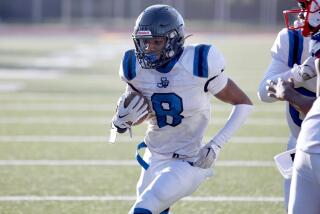Bringing HOME the glory
- Share via
BIG SANDY, TEXAS — The menu for next Sunday’s big do at the Church of God will be potluck, though there’s sure to be venison chili, finger food, sweet tea and lemonade. Corn bread will be served if anyone can make enough to feed 500, and someone has promised to make fudge from a recipe reserved for special occasions.
The junior high school and high school bands and cheerleaders will lead a pep rally, though it’s not likely anyone here will need much prompting to get worked up to a frenzy.
Lovie Smith, voted the boy most likely to succeed in the Class of 1976 at Big Sandy High, has coached the Chicago Bears to the Super Bowl, and his hometown is going all out to celebrate the journey he began amid the tall pines and gentle hills of East Texas.
“It’s like family. It’s like my brother is on television,” said Patti Rozell, a vivacious fourth-grade teacher who grew up here and was two years ahead of Smith in school.
“That’s the neat thing. We don’t look at it as just Lovie’s success. It’s ours too. It’s not like Lovie’s going to the Super Bowl, we’re all going to the Super Bowl.”
Smith was born in nearby Gladewater but grew up in Big Sandy, a dot on the map that straddles state Highway 80 about 100 miles east of Dallas, halfway to Shreveport, La. The town is neither big nor sandy. Its name comes from a railroad switch constructed at the junction of two lines near Big Sandy Creek in the 1880s.
Highway 80 parallels the railroad tracks most of the way from Dallas through Wills Point, Fruitvale, Mineola and Grand Saline, clusters of houses nosing up to the road. Most are one-stoplight towns with a gas station, a tearoom and an antiques shop. Big Sandy has declared itself “The Needlecraft Capital of the South” for the handful of local businesses that sell materials and implements for crocheting.
There has been little industry here since the cotton farms vanished, and many of the 366 students at Big Sandy schools get free or subsidized lunches. But there’s a strong sense of community among the 1,288 residents.
It’s the kind of place where everyone knows everyone else’s business and the weekly newspaper, the Big Sandy and Hawkins Journal, prints local kids’ letters to Santa every Christmas. The street leading to the single-story school building is painted with yellow paw prints, in keeping with the teams’ Wildcats nickname.
“You just never dream of somebody from Big Sandy becoming a National Football League coach,” said Carla Baker, a second-grade teacher who also was two years ahead of Smith in school.
In the tan brick City Hall and the Municipal Court -- sessions held every third Thursday at 3 p.m. -- signs in windows exclaim “We’ve Got That ‘Lovie’ Feelin” and “Big Sandy {heart} LOVIE.” Many of the cars parked on Gilmer Street have similar sentiments painted on their rear windows.
Even though Smith long ago moved away to embark upon the path that has led him to Super Bowl XLI against the Indianapolis Colts, he never really left. He returns every summer to reacquaint himself with the place and people that shaped him.
“Lovie was part of three state football championships here,” said Darold Turner, football coach and athletic director at Big Sandy High.
“He’s been a winner, he’s a winner right now, and he will continue to win in football, and he will continue to win in life.
“He’s an inspiration to every young man, young lady and even adults in this community that a small-town boy can make it big-time. You can tell he’s always been a person that has a vision. He understands exactly where he came from and knows exactly where he’s going.”
After graduating from the University of Tulsa, where he was a second-team All-American safety as a junior, Smith’s dreams stalled when he couldn’t catch on with an NFL team. He returned to Big Sandy in 1980 to coach the junior varsity Kittens, giving them a dose of discipline and direction.
Dennis Glenn, now the assistant head coach and defensive coordinator for the varsity team, played for Smith and remains a friend. He attended the Bears’ training camp two years ago at Smith’s invitation, happily switching his allegiance from the Dallas Cowboys.
When he heard 3,000 people calling Smith’s name at a practice, Glenn said, “That’s when it hit me that he was very important for that area.”
But never self-important.
“You either coach by putting fear in your players or you coach by getting their respect, and Lovie never raised his voice with us,” Glenn said. “He never got upset. He was just so patient. And I know we did things that probably deserved it, but he never lost his cool. You played for him because you didn’t want to disappoint him.
“And I think that’s why players at the pro level have responded to him. It’s because they know he is sincere, and I’m sure they’re the same way. They play hard because they don’t want to disappoint him.”
Wayne Weese, director of maintenance for Big Sandy schools, was a year ahead of Smith in class and remembers him as a fine basketball player and runner and “awesome” at dominoes during their study hall competitions.
He also found Smith unspoiled by fame when the coach returned last summer for a ceremony that gave the name Lovie Smith Drive to the short, narrow street where he had grown up.
“We sat and talked, and I realized Lovie hadn’t changed in 30 years, except he had more hair back then,” Weese said. “But he was the same Lovie.... You always felt he was going to be big.”
Smith and Indianapolis’ Tony Dungy are the first African Americans to coach teams to the Super Bowl. And Smith was among the first African American students to attend Big Sandy schools.
Rozell said she recalled no racial tension arising when integration began, the year she was in sixth grade and Smith in fourth.
“To me, it was just like, ‘We got new kids,’ ” she said.
The school district is more than 75% white. However, Lawrence Harper, a Wildcats teammate of Smith’s and president of the school board, is African American. So is the reigning Miss Big Sandy, Mandy Beecham.
“What helped our community was that right after integration, football was big and we were successful, and it kind of brought everybody together,” Glenn said. “We were all Wildcats.”
Weese credited then-coach Jim Norman for the successful transition.
“We just didn’t have the problems other schools did,” he said. “You were students and you were athletes and there was no black and white. You were part of the team.”
Smith was embraced by all, and he has returned that affection. Last June, at the street-renaming ceremony, he signed autographs and spoke at a Chamber of Commerce meeting at the high school gym. Baker brought her mother, a former school cafeteria worker whose duties included collecting kids’ lunch tickets.
“She went up and shook his hand and said, ‘You probably won’t remember me,’ ” Baker said. “He said, ‘Oh, yes I do,’ and whether he did or not I don’t know, but he made her feel like he remembered.”
Rozell asked for his autograph and was floored at his response: “He said, ‘Sure. Now, Patti, you spell your name with an “i,” correct?’
“Lovie, yay! Because my name is always misspelled. Those are the little things he remembers.
“That, to me, is why when I look at him I don’t say, ‘Oh, there’s Lovie making a million dollars.’ I think, ‘Oh, yes, we’re in the Super Bowl.’ ”
*
More to Read
Sign up for The Wild
We’ll help you find the best places to hike, bike and run, as well as the perfect silent spots for meditation and yoga.
You may occasionally receive promotional content from the Los Angeles Times.







